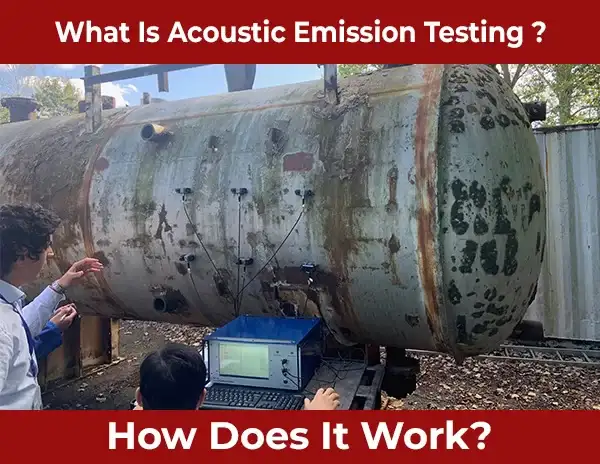What Is Acoustic Emission Testing and How Does It Work?
Have you ever wondered what those technicians were looking at when they were examining something with a large, expensive-looking machine. No, we’re not talking about the x-ray machine at the airport—we’re talking about acoustic emission testing.
Acoustic emission testing is a process that uses sound waves to inspect and test materials for damage or defects. From metals to concrete to composites, it can be used on a wide range of materials. It is often used in the construction, automotive, and aerospace industries.
In this article, we’ll explore what acoustic emission testing is and how it works. We’ll also discuss some of the benefits of acoustic emission and testing how it can help inspectors solve problems.
What Is Acoustic Emission Testing?
Acoustic emission testing, or acoustic emission monitoring, uses sound waves to detect and locate defects in materials. It is often used in the manufacturing and construction industries to detect cracks, flaws, and other defects.
It works by placing an object under stress and then monitoring any sound waves that result from it. In order to determine if there are any defects or problems, these sound waves are analyzed.
This type of testing is considered an important tool for safety and quality assurance. and it can be used to help identify potential problems before they become bigger issues.
What Problem Does It Solve?
This Acoustic testing is a process that helps identify potential problems with metal parts and welds. It does this by sending sound waves through the metal, which then bounce off any cracks or defects and return to the testing device.
The inspector can then use this information to assess the health of the metal part or weld. This information can help them decide whether or not the part is safe to continue using, and whether or not it needs to be repaired or replaced.
This is an important process, as it can help prevent failures and safety incidents. It’s also a valuable tool for quality control, as it can help ensure that products meet the required standards.

How Does It Work?
The best way to understand these type of testing is to think of it as a listening test. An inspector sends out a sound wave and then listens for the echo. Any changes in the echo will tell them about the condition of the material they’re testing.
The beauty of emission testing is that it can be used on all kinds of materials, from metal alloys to composites. It can also be used on all kinds of shapes, from small parts to large structures. And because it’s a non-destructive test, it’s ideal for use in manufacturing and quality control.
Basically, acoustic emission testing is a quick, easy way to get an idea of the condition of a material. It doesn’t take long to set up and it doesn’t damage the material in any way. So, if you need to know what’s going on inside a material, this testing is the answer.

What Are Its Benefits? Acoustic Emission Testing
This testing has a number of benefits, the most notable of which is that it’s a non-destructive testing method. That means that you can test a material without causing any damage to it, which is obviously a huge advantage.
Another big benefit is that it’s a relatively quick and easy testing method, especially when compared to other NDT methods. And because it’s a quick and easy testing method, it’s also a relatively inexpensive testing method.
Last but not least, This testing can be used to test a variety of materials, including metals, plastics, composites, and ceramics. So whatever material you’re working with, there’s a good chance that emission testing can be used to test it.
Are There Any Limitations?
Now that you know how acoustic testing works and what its benefits are, you might be wondering if there are any limitations to this technology.
And the answer is yes, there are a few. Firstly, This Testing can only be used on materials that conduct sound waves well, such as metals. And secondly, the surface of the material being tested must be smooth in order for the sensors to work properly.
That said, these limitations aren’t deal-breakers by any means. This emission testing is still an incredibly useful tool for inspector, and one that can save a lot of time and money.
Conclusion
What is acoustic emission testing, and how does it work?
This testing is a non-destructive method that uses sound waves to inspect materials for defects. It involves placing the material under stress and monitoring the resulting sound waves to detect cracks and flaws.
What industries commonly use acoustic emission testing?
emission testing finds applications in various industries, including construction, automotive, aerospace, and manufacturing, to identify potential problems and ensure safety and quality assurance.
What problems does acoustic emission testing solve?
This Testing helps identify defects in metal parts and welds by sending sound waves through the material. It allows inspectors to assess the health of the material and decide whether it requires repair or replacement, preventing potential failures and safety incidents.
How does acoustic emission testing work on different materials?
its is used on a wide range of materials, from metal alloys to composites, and shapes, from small parts to large structures. It is a non-destructive testing method, making it ideal for use in manufacturing and quality control.
What are the benefits of acoustic emission testing?
The primary advantage of This is that it's non-destructive, meaning it doesn't damage the material during testing. It is also quick, easy, and relatively inexpensive compared to other non-destructive testing methods.
Can acoustic emission testing's be used on all materials?
emission testing is most effective on materials that conduct sound waves well, such as metals. It may not be as suitable for materials that do not transmit sound effectively.
Is surface condition important for acoustic emission testing?
Yes, the surface of the material being tested must be smooth for the sensors to function accurately. Rough surfaces may interfere with the detection of acoustic emission signals.
Can this testing replace other non-destructive testing methods?
So this testing complements other non-destructive testing methods but does not replace them. When used in combination, it provides a more comprehensive evaluation of a structure's integrity.
How is acoustic-emission-testing useful in quality control?
Acoustic emission testing helps ensure that products meet required standards by detecting defects and flaws during the manufacturing process. This ensures higher quality and safety of the end products.
Is emission testing a reliable method for safety assurance?
Yes, acoustic emission testing is a reliable method for safety assurance, as it allows inspectors to identify potential issues in materials and structures, enabling timely intervention and preventing accidents.





